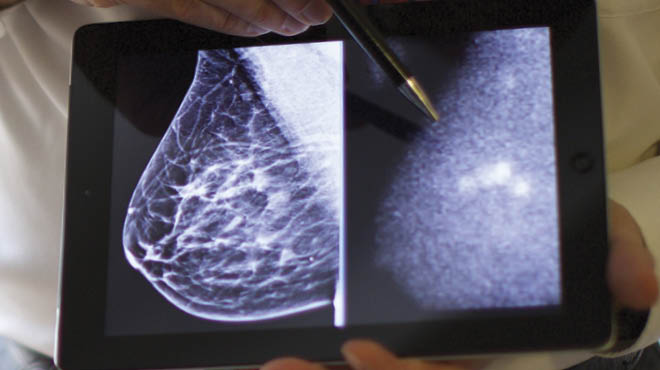Recent Posts
-

-
 Patient StoriesA lifesaver saved: An EMS veteran’s journey from rescue to recoveryNovember 14, 2025
Patient StoriesA lifesaver saved: An EMS veteran’s journey from rescue to recoveryNovember 14, 2025 -

Preparing for your breast biopsy

"No news is good news." That's an appropriate adage when considering breast health. The best result after a mammogram is that nothing was found, or a routine self-exam only finds regular breast tissue. According to the saying, if something is abnormal, you would be told about it.
That's why it's normal to feel anxious if you require follow-up care after a breast exam, especially if your health care provider refers you to a surgeon for a breast biopsy. This procedure removes a small sample of your breast tissue for laboratory testing. One way to ease your mind is to gather information so you know what to expect.
Breast biopsy basics
A breast biopsy is a procedure to evaluate a suspicious area in your breast. It may be recommended if:
- You or your health care provider feels a lump or thickening in your breast, and your care team suspects breast cancer may be present.
- Your mammogram shows a suspicious area in your breast.
- An ultrasound scan or breast MRI reveals a suspicious finding.
- You have unusual nipple or areolar changes, including crusting, scaling, dimpling skin or a bloody discharge.
During your biopsy, a surgeon or radiologist will collect a sample of tissue that will be used to identify and diagnose abnormalities in the cells that make up breast lumps, other unusual breast changes or suspicious areas. The results of your biopsy can help determine whether you need additional surgery or other treatment.
Questions to ask
Before your biopsy, you may meet your health care provider in the clinic to discuss the procedure. This is a great time to ask questions and gather additional information.
Here are a few questions to consider asking:
- What is the exact location of my biopsy?
- What type of breast biopsy procedure will be used?
- Will part of or the entire lump be removed?
- What type of anesthesia will be used, or will I be awake during the procedure?
- Will the biopsy leave a scar?
- How soon can I resume regular activities?
- What types of tests will be done to the tissue?
- How soon will I get the results?
Preparing for your biopsy
Before your breast biopsy, tell your health care provider about medications you are taking, about any allergies and if you are not able to lie on your stomach for an extended time.
Wear a bra to your appointment. Your health care team may place a cold pack against the biopsy site after the procedure, and the bra can hold the cold pack in place and provide support for your breast.
Types of biopsy procedures
Several breast biopsy procedures are used to obtain a tissue sample from the breast.
Your health care provider may recommend a particular procedure based on the size, location and other characteristics of the breast abnormality:
- Fine-needle aspiration biopsy
This is the simplest type of breast biopsy and may be used to evaluate a lump. For the procedure, a thin needle is passed into the lump. The needle is attached to a syringe that can collect a sample of cells or fluid from the lump. - Core needle biopsy
This type of breast biopsy may be used to assess a breast lump that's visible on a mammogram, ultrasound, MRI or that your health care provider feels, or palpates, during a clinical breast exam. A radiologist or surgeon uses a thin, hollow needle device to remove small cores of tissue, about the size of a grain of rice, from the breast mass. An imaging technology is frequently used to visualize the area of interest so the tissue can be sampled accurately. This may include ultrasound, stereotactic (mammogram) or MRI. One or more small clips are placed into the biopsy site to mark where the tissue was taken from, and often a quick mammogram picture is taken after the biopsy. - Surgical biopsy
During a surgical biopsy, a portion or all of your breast mass will be removed to be examined. It is usually done in an operating room or clinic procedure room using local anesthetic to numb your breast, sometimes with sedation given through a vein in your hand or arm. If the breast mass can't be felt, a radiologist may use a technique called wire localization to map the route to the mass for the surgeon. During wire localization, the tip of a thin wire is positioned within the breast mass or just through it. This is usually done right before surgery. During surgery, the surgeon will attempt to remove the breast tissue of interest along with the wire.
After your breast biopsy
After your biopsy, you will be able to go home the same day to recover. You may have bandages, an ice pack, stitches, glue or other dressings. You will be given instructions about how to care for the biopsy site. In most cases, you will be able to resume usual activities the next day. Bruising and tenderness is common. Using ice frequently for the first one to two days and wearing a snug bra day and night for the first week can minimize bruising and swelling. You may take a nonaspirin pain reliever for discomfort, unless otherwise instructed by your health care provider.
Waiting for your biopsy results can be difficult. It can take up to two weeks for all test results from the procedure to be available, and your care team will contact you as soon as possible.
During this time, your breast tissue is sent to a lab where it is examined using a microscope and special procedures. If your breast biopsy reveals normal results or benign breast changes, your care team will contact you after confirming the results with the radiologist and pathologist. Sometimes a clear diagnosis is not possible from a sample or the pathology result does not line up with the imaging studies. In that case, you may need another procedure or surgery to obtain more tissue to further evaluate the area.
If your results show that breast cancer is present, a pathology report will include information about the cancer itself, such as what type of breast cancer you have and additional information, such as whether the cancer is hormone receptor positive or negative. You and your care team can then develop a treatment plan that best suits your needs.
Talk with your care team if you have any questions or concerns during your breast biopsy. Their goal is to ease any anxiety and provide compassionate care during this stressful time.
By Mayo Clinic Health System staff.



